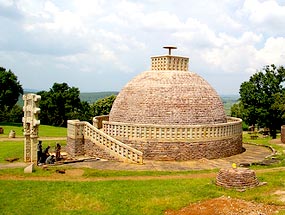Sanchi Stupa is situated in the state of Madhya
Pradesh. This article will throw light on the Great Stupa at Sanchi,
India.
Sanchi Stupa

Location: Sanchi, Madhya Pradesh
Founded By: Maurya Emperor Ashoka
Founded In: 3rd century BC
Status: UNESCO World Heritage Site
Sanchi is a village in Madhya Pradesh, believed to be one of the most
important places in India associated with Buddhism. It is situated at a
distance of approximately 52 km from the city Bhopal of India, also
known as the City of Lakes. Sanchi is known for housing a number of
Buddhist structures, like stupas, monasteries, temples, pillars, etc.
Most of these structures date back to the period between 3rd century BC
and 12th century AD and are a part of UNESCO's list of World Heritage
Sites.
Mauryan emperor Ashoka was the founder of all the stupas at Sanchi,
which were constructed in the honor of Lord Buddha. The most impressive
as well as the most significant one of all the stupas is the Great
Sanchi Stupa. It is a simple hemispherical brick structure, which has
been built over the relics of Lord Buddha. One of the best-preserved
stupas in central India, the Great Stupa at Sanchi is adorned by a
chhatra, a parasol-like structure, intended to honor and protect the
relics.
Surrounding the main Sanchi Stupa is a path, used for circumambulation.
The path stands encircled by a railing, with four carved gateways that
face the four different directions. These gateways are said to be carved
somewhere around 100 AD. A unique feature of the all the stupas at
Sanchi, including the Great Stupa, is that they do not have any images
of Lord Buddha in human form. Inanimate figures, like footprints, tree,
wheels and thrones, have been drawn or carved to represent the
symbolical form of the Lord.
However, the figure that is most extensively used to depict Lord Buddha
is a lotus flower. During the Shunga period, Sanchi Stupa was extended
to quite an extent. Its facade was decorated with stones, railings and
staircase, along with a harmika on the top. Sculptures, with different
motifs and designs, have been chiseled to ornament the railings and
gates of the stupa. The gateways of the Great Sanchi Stupa have been
exquisitely festooned with illustration of incidents from the life of
the Buddha.
The ornamentation the stupa gateways also includes the portrayal of
male and female tree spirits. Since the female tree spirits are believed
to be a symbol of fertility, they are usually used by Buddhists in the
form of welcoming figures. The site where the village of Sanchi stands
was discovered by General Taylor, in the year 1818. Later, 1919, an
archaeological museum was established in Sanchi, by Sir John Marshall.


